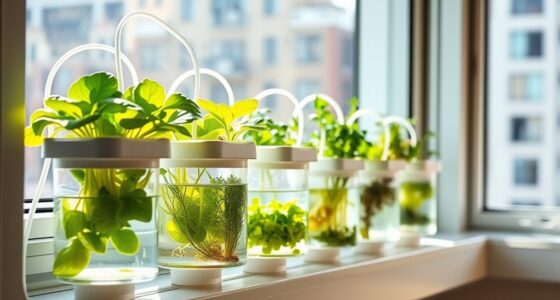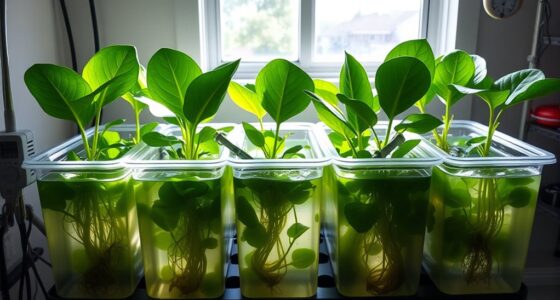In hot weather, you need to regularly monitor and adjust your nutrient solution to keep plants healthy. Focus on maintaining the right pH (around 5.5 to 6.5) with pH Up or Down as needed, and check EC levels to ensure proper electrolyte balance. Increase water top-offs to compensate for evaporation and prevent nutrient imbalances. Consistent testing and adjustments help your plants thrive despite the heat—if you want detailed tips, keep exploring how to fine-tune your solution effectively.
Key Takeaways
- Regularly test and adjust pH to maintain the optimal range of 5.5 to 6.5 for nutrient availability.
- Monitor and control EC levels to prevent nutrient deficiencies or salt buildup caused by increased evaporation.
- Use fresh water and nutrient solutions frequently to compensate for evaporation and prevent concentration imbalances.
- Incorporate automated pH and EC controllers for real-time adjustments during hot weather.
- Ensure proper circulation and prevent stagnant solutions to maintain even nutrient distribution and solution stability.

Adjusting your nutrient solution is crucial for ideal plant growth and health, especially during hot weather when plants are more vulnerable. Proper pH balancing ensures that nutrients remain available and accessible to your plants, preventing deficiencies or toxicities. When temperatures rise, the pH of your solution can shift more rapidly, so regular testing and adjustment are necessary. Aim for a pH range of 5.5 to 6.5, depending on your crop, and use pH adjusters like pH Up or pH Down to fine-tune the solution. Consistent monitoring helps maintain best nutrient uptake and supports vigorous growth despite the heat. Additionally, some advanced air purification technologies can improve the overall environment of your grow space, reducing stress on plants from airborne contaminants. Electrolyte management becomes even more critical during hot weather, as high temperatures can cause increased transpiration and stress on your plants. The electrolytes—primarily minerals like potassium, calcium, and magnesium—are crucial for maintaining cell function, water regulation, and overall plant resilience. Hot conditions can accelerate the depletion of these essential ions, so you need to confirm your nutrient solution has the right balance. Regularly check the electrical conductivity (EC) to gauge the electrolyte concentration, and adjust your feed accordingly. If EC levels drop, it indicates your plants aren’t getting enough nutrients, and you should replenish the solution with appropriate fertilizers. Conversely, if EC is too high, dilute your solution to prevent nutrient burn or osmotic stress. During heatwaves, you might notice your plants showing signs of nutrient deficiencies, which could stem from imbalanced pH or electrolyte levels. To combat this, increase the frequency of solution changes and consider adding supplements to restore balance. Make sure your water source is clean and free from contaminants that could alter pH or electrolyte levels. Also, ensure your system’s circulation is best—stagnant solution can lead to uneven nutrient distribution and pH fluctuations. Using automated pH and EC controllers can simplify this process, providing real-time adjustments and reducing manual labor. Lastly, remember that hot weather can cause increased evaporation, concentrating salts and electrolytes in your solution. This makes regular top-offs with fresh water and nutrients a necessity. By actively managing pH balancing and electrolyte levels, you give your plants the best chance to thrive in high temperatures. Consistent adjustments, vigilant monitoring, and a proactive approach to maintaining the solution’s chemistry will help keep your hydroponic system healthy and productive even during the hottest days.
Frequently Asked Questions
How Often Should I Test My Nutrient Solution During Hot Weather?
You should test your nutrient solution daily during hot weather to maintain pH stability and proper nutrient concentration. High temperatures can cause fluctuations that affect plant growth, so regular checks help you catch changes early. Use a reliable pH meter and EC tester, and make adjustments as needed to keep conditions ideal. Consistent testing ensures your plants receive the right nutrients and stay healthy despite the heat.
Can Temperature Fluctuations Affect Nutrient Uptake Efficiency?
Imagine your plants wilting despite a well-balanced nutrient solution—that’s often caused by temperature fluctuations. Yes, they can affect nutrient uptake efficiency by disrupting temperature stability. Sudden changes can slow root activity. To minimize this, maintain consistent temperatures and guarantee proper solution aeration. This keeps the nutrients available and accessible, helping your plants thrive even during temperature swings. Consistency is essential for ideal growth.
Are There Specific Nutrients More Prone to Imbalance in High Temperatures?
You might wonder if certain nutrients are more prone to imbalance in high temperatures. In hot weather, nutrient stability becomes a concern, as some nutrients are more temperature sensitive than others. For instance, iron and manganese can become less available, while calcium and magnesium tend to remain stable. You should monitor your solution closely, adjusting pH and nutrient levels regularly to prevent deficiencies caused by temperature-induced nutrient imbalances.
What Are Signs of Nutrient Deficiency Caused by Hot Weather?
You might notice nutrient deficiencies during hot weather as your plants show stunted growth, yellowing leaves, or poor fruit development. These signs can be worsened by pest infestations or root rot, which thrive in warm, moist conditions. Hot temperatures can cause nutrient imbalances, making deficiencies harder to detect and treat. Keep a close eye on plant health, maintain proper oxygen levels in the solution, and stay vigilant for pests and root issues.
How Do I Prevent Algae Growth in Nutrient Solutions During Summer?
To prevent algae growth in your nutrient solutions during summer, focus on algae prevention strategies like maintaining solution clarity. Keep your reservoir covered to limit light exposure, which algae need to thrive. Regularly clean and sterilize your system, and use opaque containers to block light. Monitor your nutrient solution closely, and avoid excess nutrients that can promote algae. These steps help make certain your hydroponic system stays healthy and algae-free in hot weather.
Conclusion
Remember, adjusting your nutrient solution for hot weather isn’t just a suggestion—it’s essential for healthy plant growth. If you think it’s too complicated or time-consuming, consider that small daily tweaks can prevent issues like nutrient deficiencies or root damage. Staying attentive and proactive keeps your plants thriving, even in the heat. So don’t let the summer stress you out—just stay vigilant, make quick adjustments, and enjoy a bountiful, healthy harvest.











